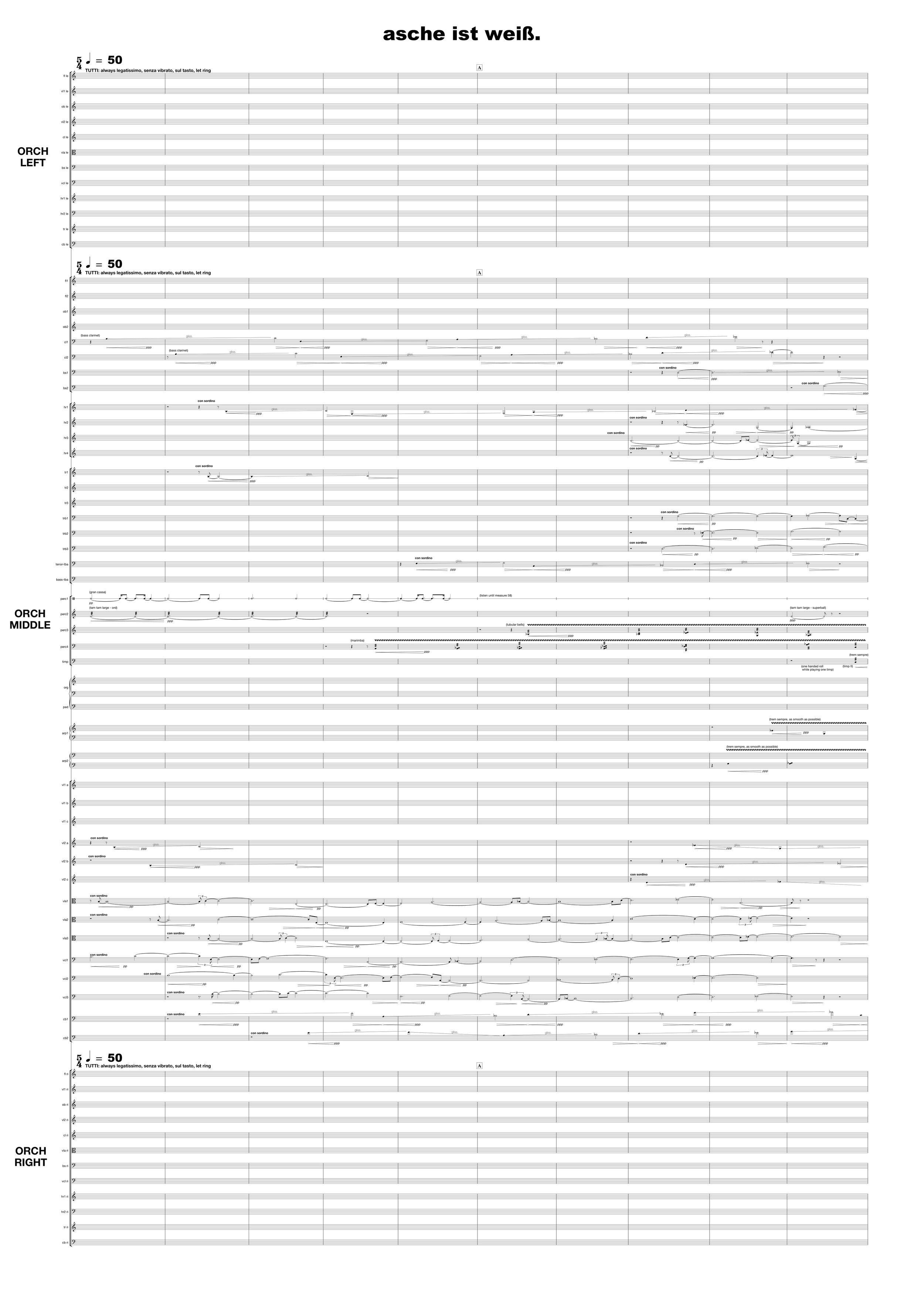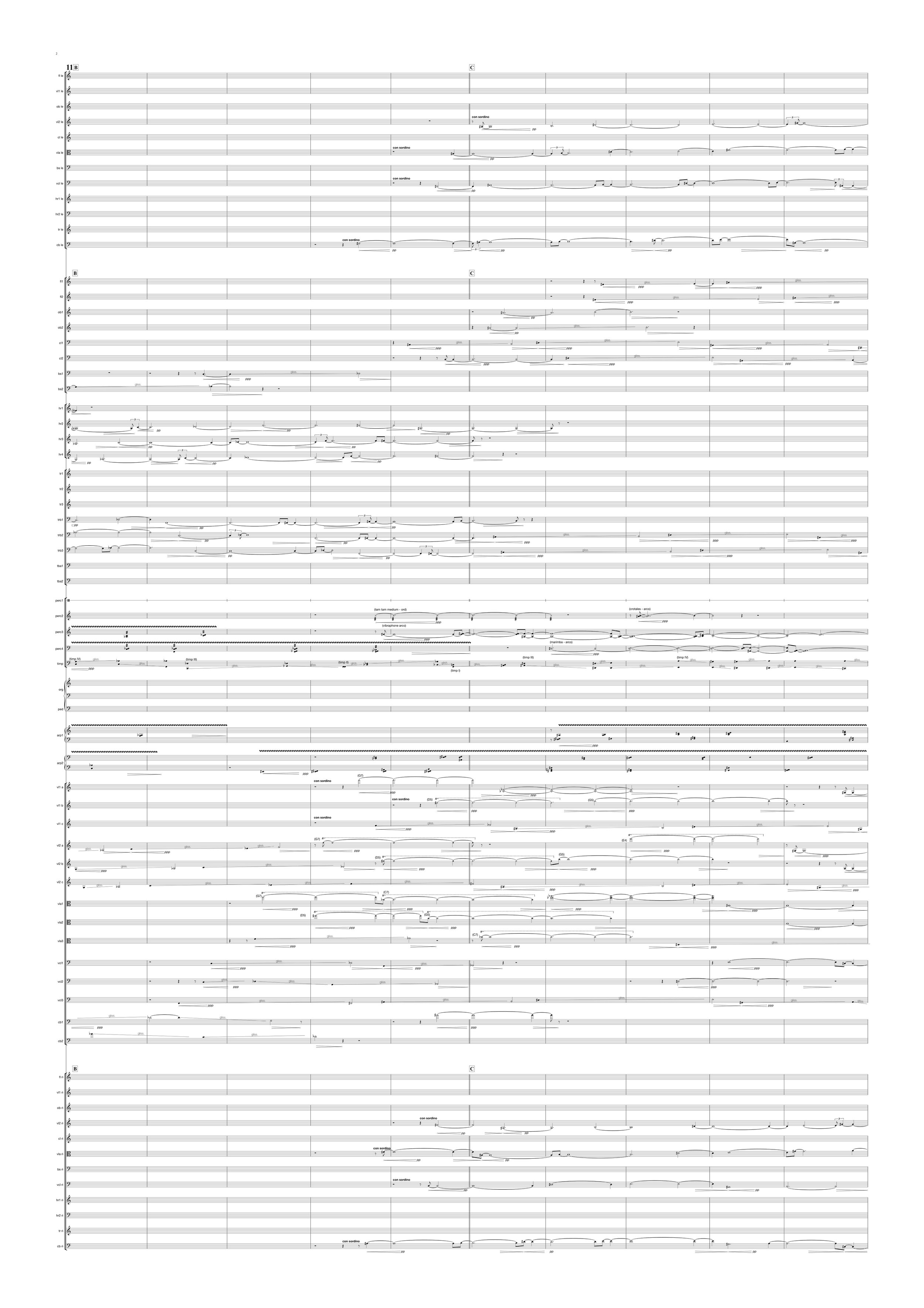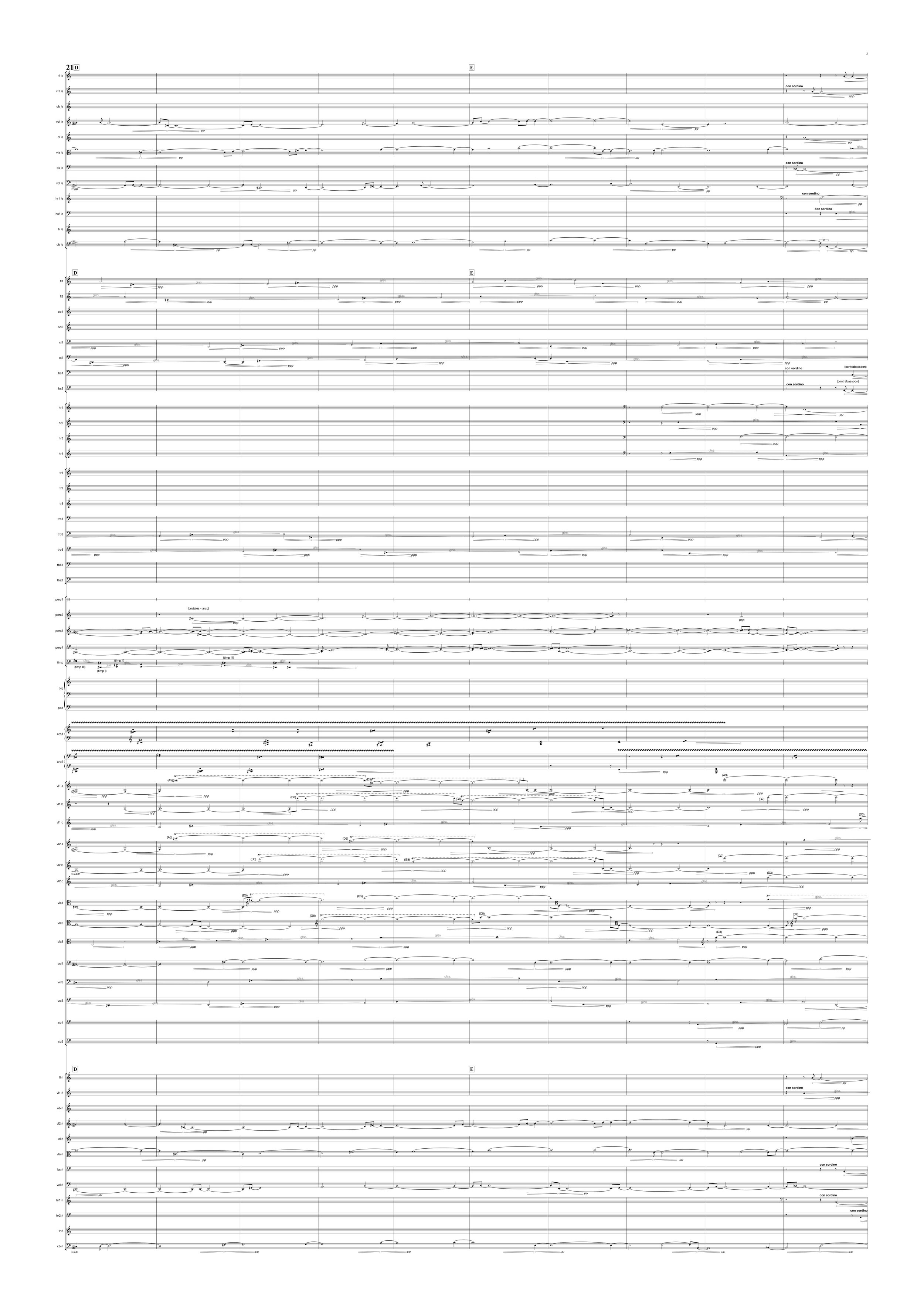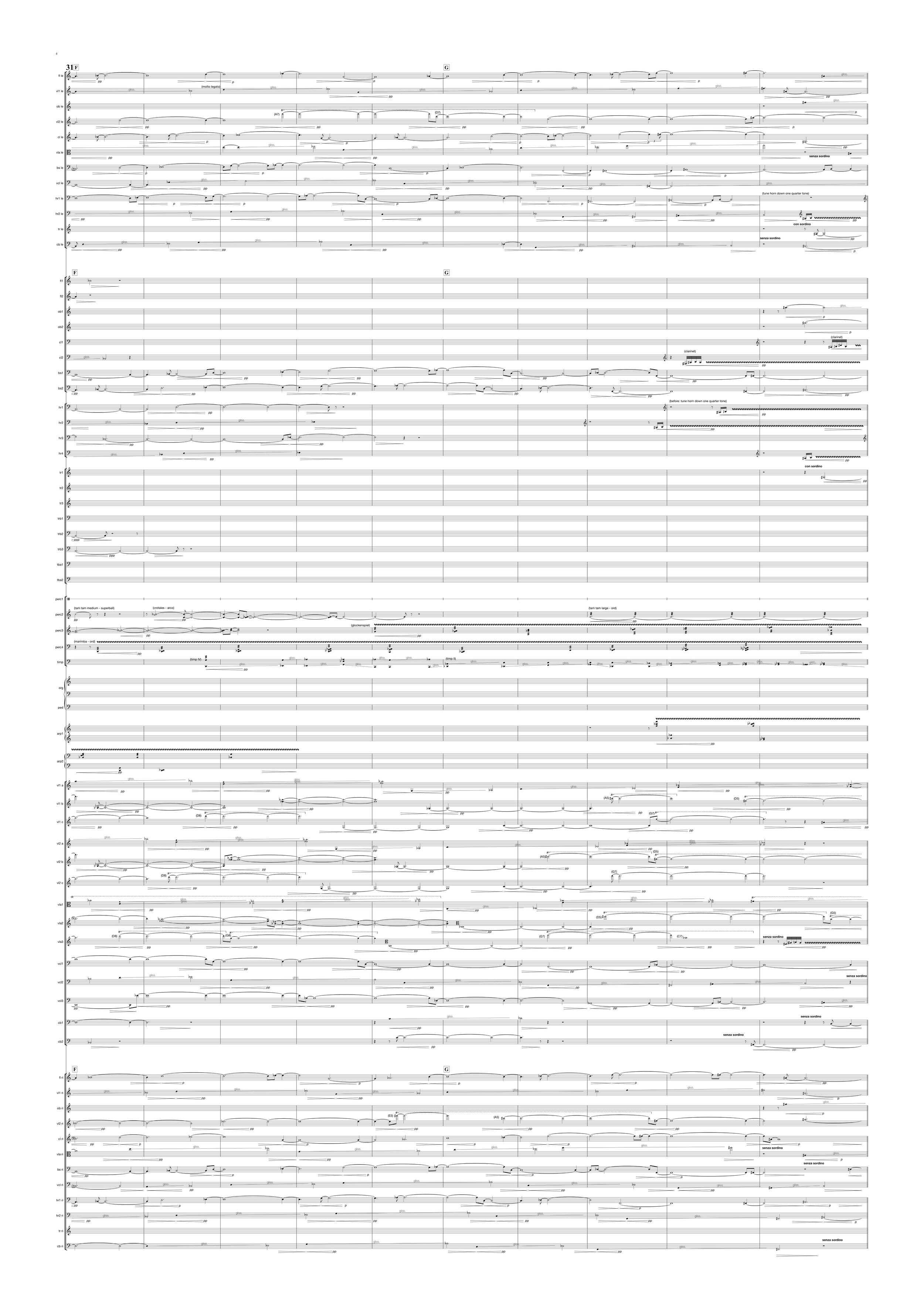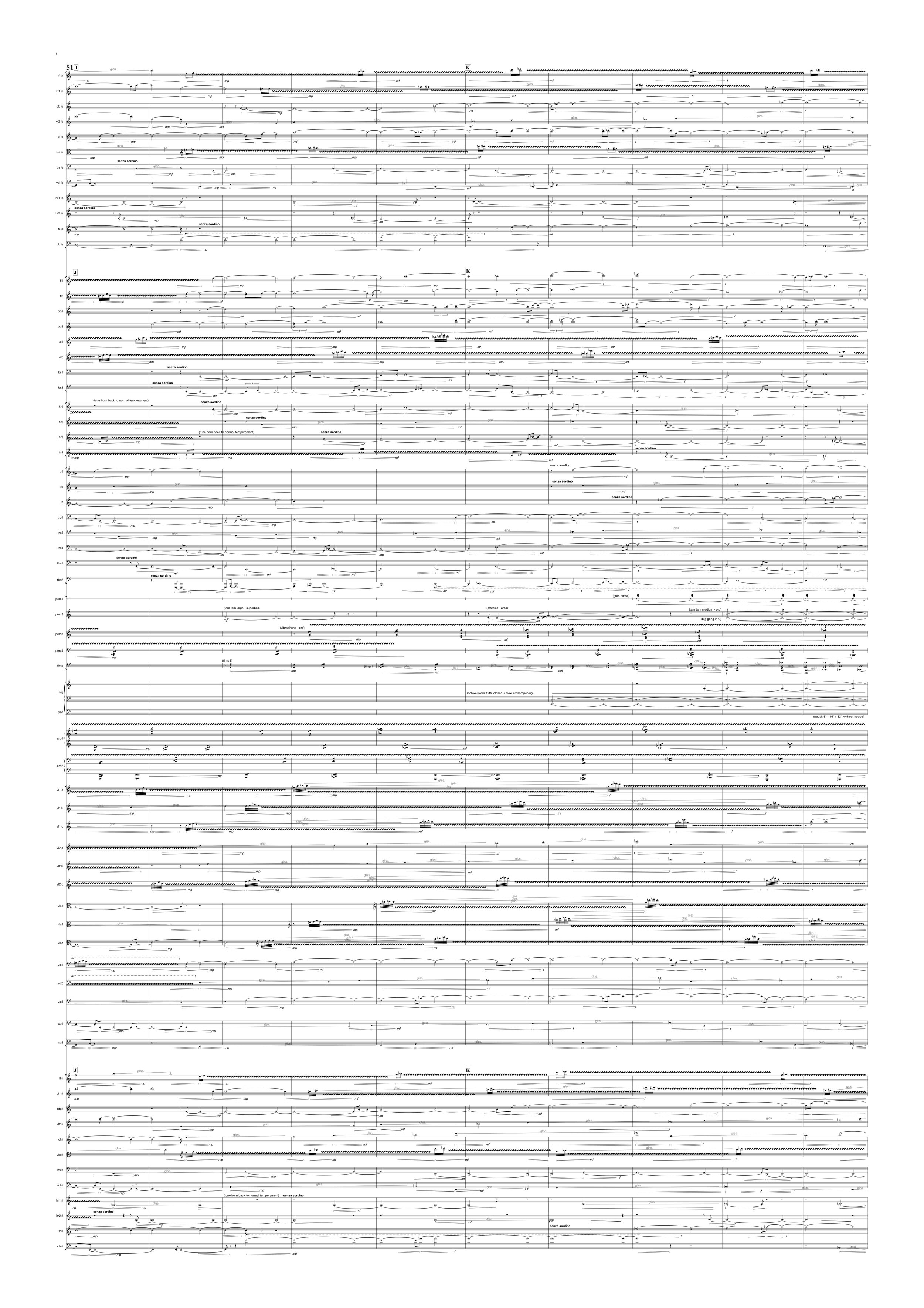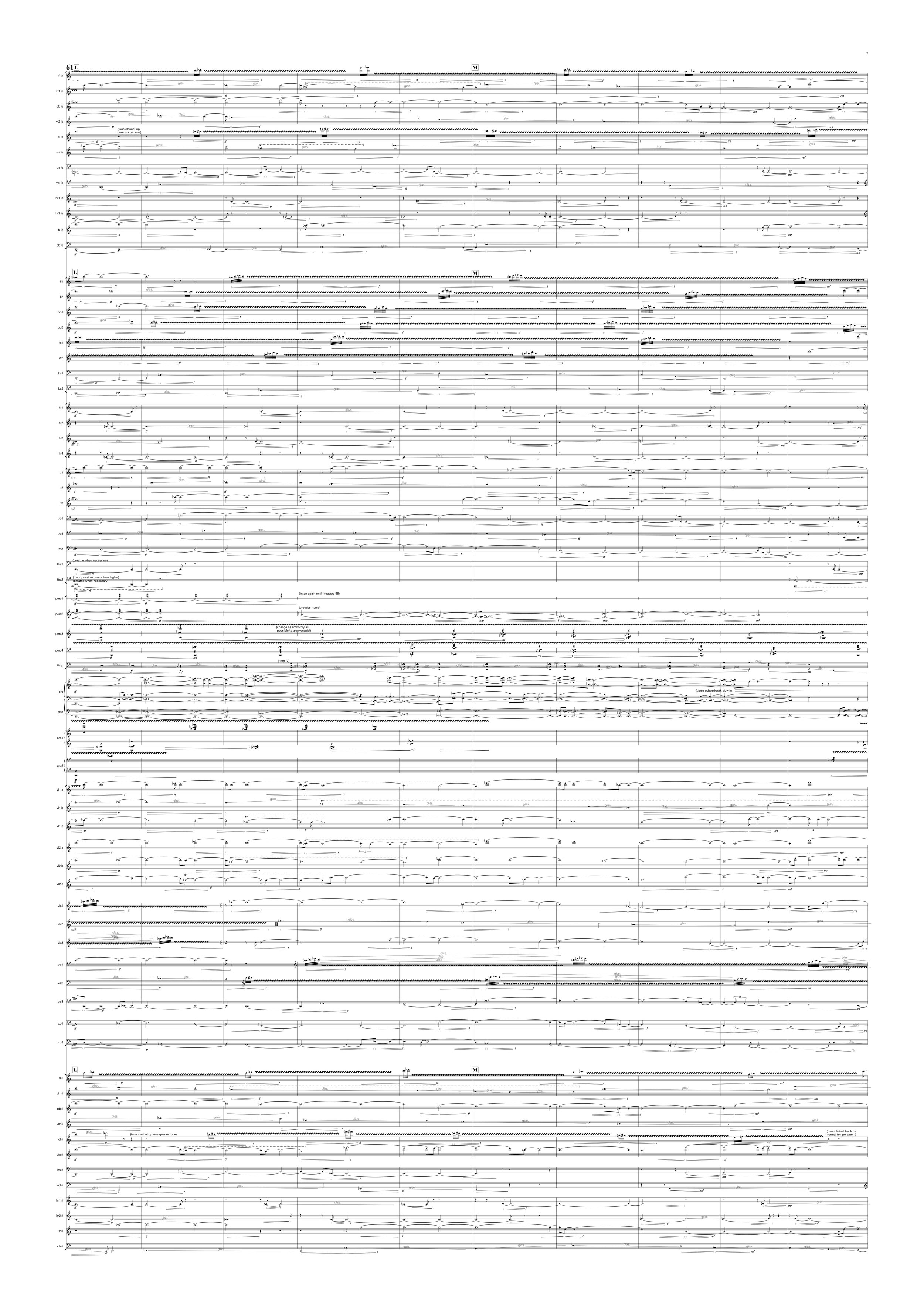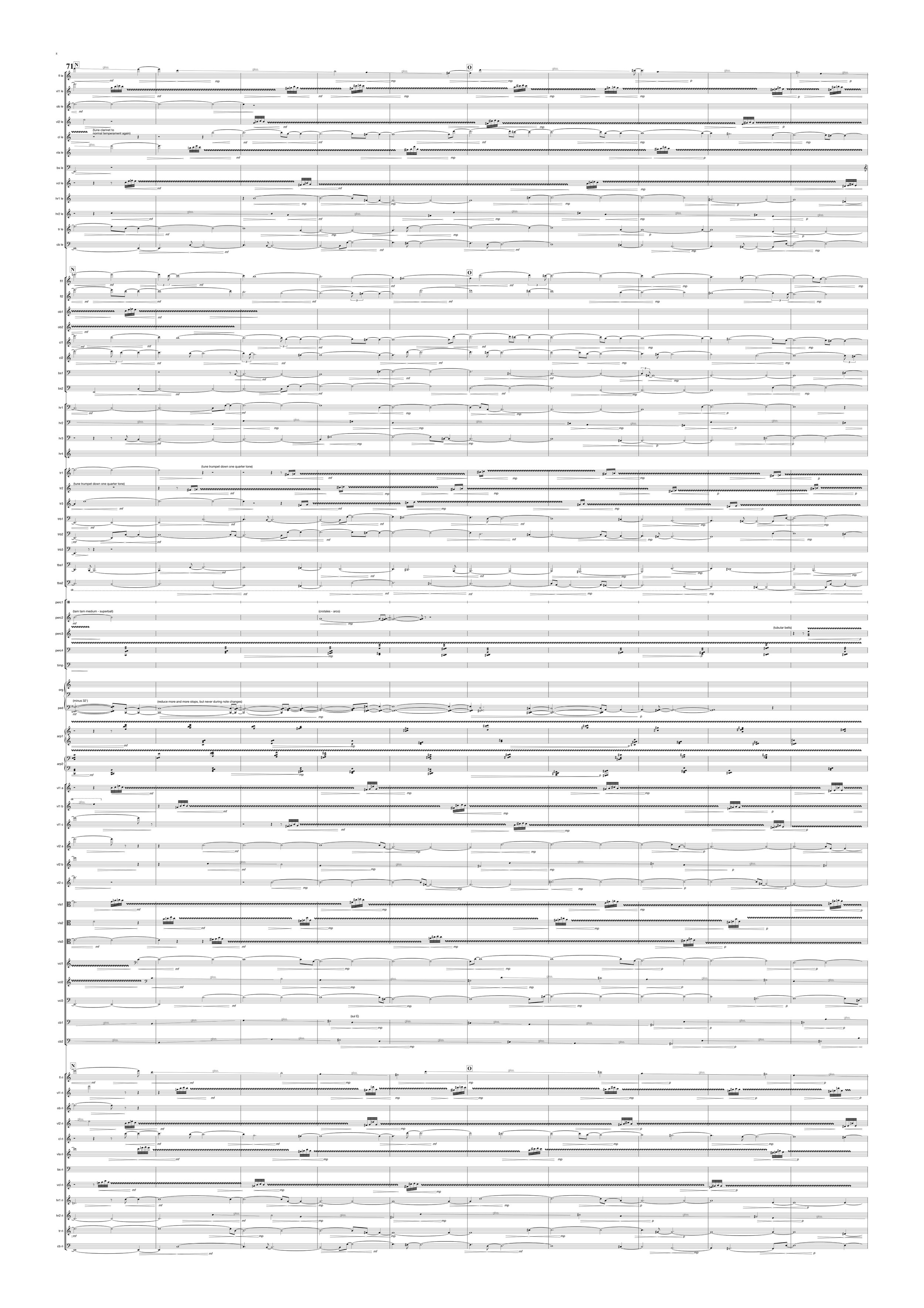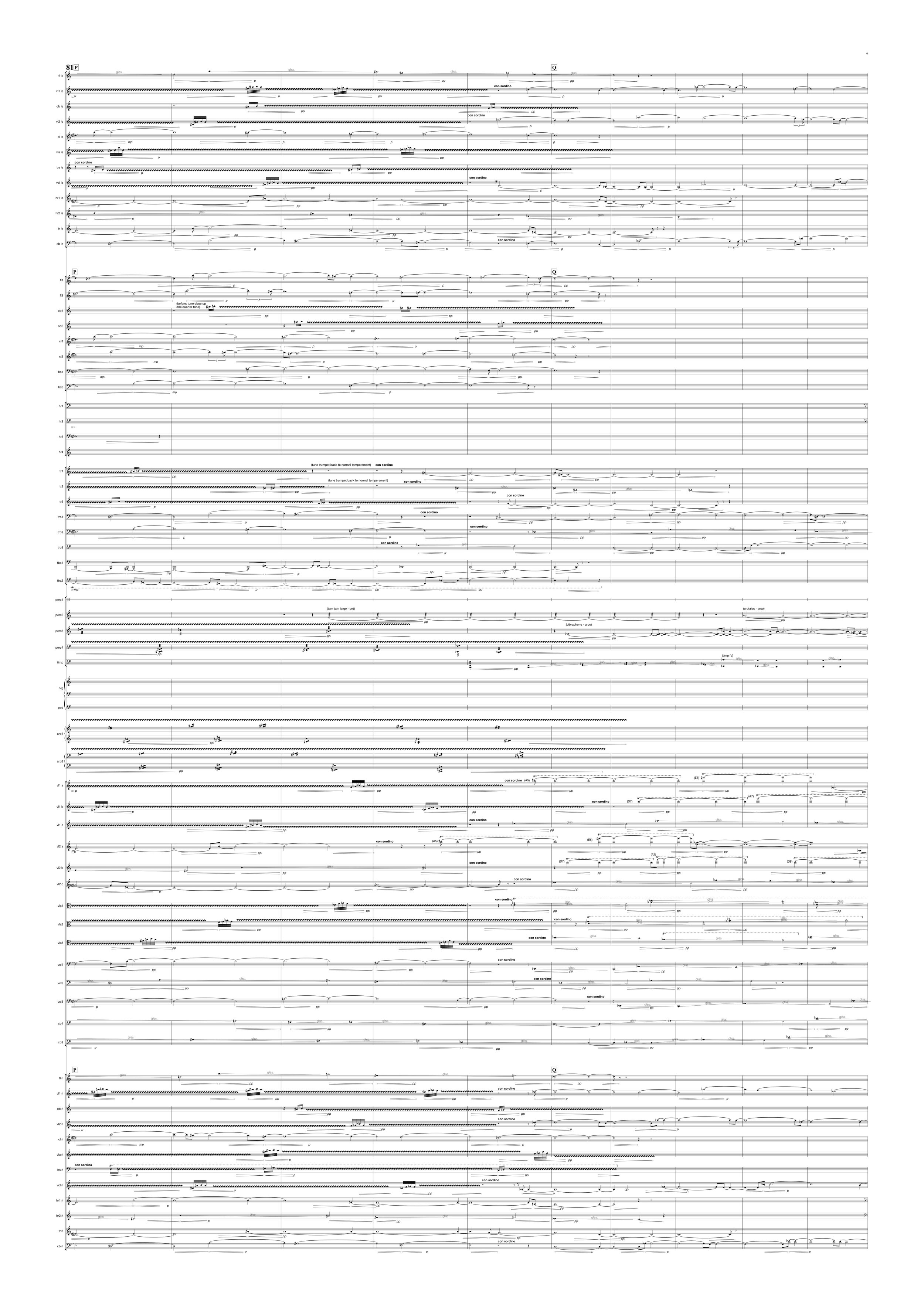asche ist weiß.
[ash is white.] (Linzer Fassung)
for three orchestras and percussion (2020)
duration: 10’
instrumentation: wood (4.4.4.4) — brass (8.5.3.2) — perc (5) — organ (1) — harps (2) — strings (16.14.12.10.8)
premiere: 01/01/2023 in the Brucknerhaus Linz, Bruckner Orchester Linz, soloist: Christoph Sietzen, direction: Markus Poschner
self-publishing edition: make contact
Eine kleine Idee des Kreises und der Zeit.
Klang wird verursacht durch die Schwingung von Luftmolekülen. Dabei wird das Luftmolekül in eine Richtung versetzt, dann in die entgegengesetzte Richtung, bis es nach einer bestimmten Zeit wieder in seine Ausgangslage zurückschwingt. Unser Trommelfell nimmt diese periodischen, zeitlichen Schwingungen wahr. Man könnte also sagen, dass Musik nichts anderes ist als das Wahrnehmen der Zeit.
Wir kennen alle die Erfahrung: wir hören Musik, die uns im Innersten bewegt, und die Zeit scheint stehen zu bleiben. Paradoxerweise löst sich also die Zeit in Zeitlosigkeit auf, sobald wir die Zeit, den Klang wahrnehmen.
Wenn man unter Ewigkeit keine unendliche Zeitdauer versteht, sondern eine Un-Zeitlichkeit oder Zeitlosigkeit, dann lebt derjenige in der Ewigkeit, der die Zeit wahrnimmt.
Die Feststellung “asche ist weiss” deutet auf diese Logik der Zeit, Zeitlosigkeit und Ewigkeit. Dabei ist die Zeitlosigkeit oder das Transzendentale an sich nichts Besonderes. Die reine Erfahrung ist im hier und jetzt. Das hier und jetzt die einzige Realität, die wir haben. Dennoch ist es ziemlich schwierig im hier und jetzt zu sein.
Das Stück versucht durch die Wahrnehmung von Klang dieses Gefühl der Zeitlosigkeit zu erreichen. Versucht man das Gefühl der Zeitlosigkeit festzuhalten, so scheitert man, da man die Zeit nicht festhalten kann. Man kann sie nicht be-greifen, sondern nur wahrnehmen.
Dieses Wahrnehmen und zugleich Loslassen der Zeit kann man als unendlichen Kreislauf beschreiben. (genauso wie die Zeit selbst, siehe unten Plancksches Wirkungsquantum).
Asche ist ein Symbol für die Vergänglichkeit der Zeit. Vergänglichkeit beinhaltet zugleich immer auch einen fruchtbaren Neuanfang. (UA Neujahrskonzert 2021 Linz).
Das Stück basiert auf der Zahlenfolge 9o6 (doppelte Dauer von 4’33”, das selbst in 3 Teilen gegliedert ist. Folgt man der Idee des Kreises im Großen und im Kleinen, dann wäre 4’33” von Cage der erste Satz und mein Stück der zweite und dritte - juchuuu!), die in sich selbst kreisförmig ist, da die Zahlen 9 und 6 im Kreis gespiegelt werden können. Ordnet man die Zahlen als Intervalle an (none / sexte), entsteht eine unendliche Sequenz, die sich durch den gesamten Quintenzirkel bewegt. So wie das weisse Licht alle chromatischen Farben enthält. asche ist weiss.
Im Übrigen hat ein Octopus drei Herzen.
ENGLISH TEXT
GENERAL
Sound is caused by the vibration of air molecules. The air molecule is moved in one direction, then in the opposite direction until it swings back to its original position after a certain time. Our eardrum perceives these periodic, temporal vibrations based on time. So you could say that music is nothing else than the „perception of time“ (Wahrnehmung der Zeit).
We all know this experience: we hear music that moves us in our innermost being, and all of the sudden time seems to stand still. Paradoxically, therefore, time itself dissolves into timelessness as soon as we simply perceive time, which we do as soon as we perceive sound.
If one doesn’t think of eternity as some sort of infinite long duration of time, but instead of non-time or timelessness, then the one who simply perceives time / timelessness, lives in eternity.
The statement asche ist weiß. (“ash is white.”) points to this logic of time, timelessness and eternity. Timelessness or the transcendental in itself however is nothing special or extraordinary. The pure experience is in the Here and Now. The Here and Now is the only reality we have. Yet it is quite difficult to be in the Here and Now.
The piece tries to achieve this feeling of timelessness through the simple perception of sound. If you try to capture this feeling of timelessness, you fail, because you cannot capture time. You cannot grasp it, you can only experience it.
This perception and at the same time letting go of time can be described as an infinite circle - just like time itself, which on a quantum level of physics moves in small circles as well (= Planck constant).
Ash is a symbol for this impermanence of time. Like ash, the destruction and impermanence of things always includes a prosperous new beginning.
The piece was composed for a new year's concert. That’s why this idea of having circles on the biggest and smallest level is the foundation of the piece.
SPECIFIC
Right before this piece will be a performance of John Cage’s 4’33’’ which will directly lead into asche ist weiß.
The fascinating fact about 4’33’’ is that it actually consists of 3 movements. The piece is nothing more than empty form defined by time boundaries where filled silence can occur.
asche ist weiß. is trying to re-interpret this idea of timeless silence by using nothing but empty form.
Therefore the basis of the piece are the numbers 9o6, which is double the time of 4’33’’. If one follows through the idea of the empty form and connectedness through big circles (new year) and small circles, then 4’33’’ (=small circle consisting of 3 movements) would be the first part and asche ist weiß. would form the second and third part, thus forming a bigger circle with the numbers 9o6, which themselves are circular since those numbers 9 and 6 can be mirrored in a circle (9 is the same as the number 6 just upside down and vice versa).
Following the circular idea, the intervallic structure of the whole piece consists of nothing more than a sequence of ninths (9) and sixths (6): starting with the note ‚b‘ going up one small ninth (9) going to ‚c‘. Then going down (0) one small sixth (6) down to ‚e‘. Then again going up to ‚f‘ (9) and going down (0) to ‚a‘ (6). etc. pp.
When continuing this pattern one will wind up going through the whole circle of fifths like a massive wheel of time slowly turning from one key of fifths to the next. Or like the light of ‚weiß‘ which contains all possible chromatic colours of light.
At the intersection between the two parts of the piece the whole cycle starts to go backwards: now going one ninth (9) down and one sixth (6) going up.
The form on all levels from the large form to the rhythmic form thus is: 9 to 6 (which is the same as 3 to 2 = 6 to 4 = 60 measures to 40 measures). The first 60 measures are divided in 3 sections (9-6 15-10 12-8 = 60measures)andthelast40measuresin2sections
(10 - 15 6 - 9 = 40 measures) always keeping the proportion of 9 to 6 within the sections and also between the sections themselves. All five sections of the piece together are forming a mirror sequence(9-6 15-10 12-8 10-15 6-9)whichcanbereadbackwardsandforward (= the idea of a circle where up is down and left is right).
This very mirror sequence is also the rhythmic foundation of the whole piece, 9 eights, followed by 6 eights, followed by 15 eights, etc. pp. (again following the circular idea on all levels).
Looking into the score one sees only empty numbers and relationships within proportions on all organisational levels of the composition (large form, intervals, rhythm, etc.).
However, while hearing the music one doesn’t hear a single number but rather an undefined cloud of sound that is endlessly moving through time and space.
The goal of all this seemingly overloaded intellectual number stuff is precisely this: that you don’t hear the numbers in the end. Therefore one only perceives and enjoys the ever changing sound (and not my current superficial emotions put to music) hopefully coming closer to the never changing timelessness of eternity and the deeper emotional presence in the Here and Now. Simply noticing that asche ist weiß.
Also incidentally, an octopus has three hearts.

